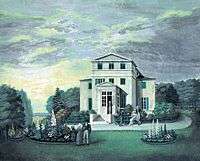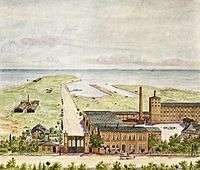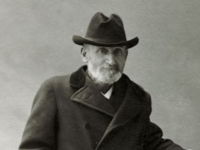Hellerup
Hellerup (Danish pronunciation: [ˈhɛlˀəʁob]) is a district of Gentofte Municipality in the suburbs of Copenhagen, Denmark. The most urban part of the district is centred on Strandvejen and is bordered by Østerbro to the south and the Øresund to the east. It comprises Tuborg Havn, the redeveloped brewery site of Tuborg Breweries, with the Waterfront Shopping Center, a marina and the headquarters of several large companies. Other parts of the district consists of single family detached homes. Local landmarks include the science centre Experimentarium and the art Øregaard Museum.
Geography
With an area of approximately 515 hectares, Hellerup covers 20% of the municipality. The district is bounded by the municipal border with Copenhagen (Østerbro) to the south, the Øresund to the east, Charlottenlund Forrest to the north, Lyngbyvej to the southwest and Niels Andersens Vej/Eivindsvej to the northwest. As of a January 2012, Hellerup had a population of 18,781, equaling 25% of the municipal population.[1]
The Hellerup postal district (2900 Hellerup) includes a somewhat larger area since part of Østerbro has the postal code 2900 Hellerup.
History
Country houses and open countryside

In spite of its name, with the suffix -rup, Hellerup does not originate in an old village. In the 18th century the area was still open countryside with scattered country houses. One of them, Lokkerup, was renamed Hellerupgård when it was acquired by Johan David Heller in 1748. It would later lend its name to the modern district of Hellerup. Hellerupgård was later purchased by the merchant and shipowner Erich Erichsen. He commissioned the French architect Joseph-Jacques Ramée to built a new house in 1802. Other country houses included Øregård, Blidah and Taffelbay.
One of the oldest properties in the area was Vartov, a former watermill which had been acquired by Frederick II in 1566 and used as a hunting lodge. It was converted into a hospital for the poor in 1607 and later used as a home for beggers after a new hospital was built closer to the city. The navel officer Charles Frédéric le Sage de Fontenay acquired it in the 18th century and converted it into a country house.
Harbour and early industry

A harbor was built on the coast between 1869 and 1873. The new Tuborg Brewery was inaugurated that same year.[2]
C.L. Ibsen and redevelopment of the area

In 1887, Carl Ludvig Ibsen began to acquire land in the area with the intension to sell it off in lots to developers and private citizens. He purchased Hellerupgård, Lille Mariendal and Slukefter in Hellerup as well as Smakkegård, Rygård, Lundegård and Stengård in Gentofte. The land in Hellerup alone added up to 37 hectares. He also reclaimed an area along the coast just north of Tuborg Breweries, leading to the creation of the three parallel streets resulted in the streets Frederikkevej, Marievej og Carolinevej. He did not build on the land himself but prepared it with sewers and roads and then sold it off in lots to developers and private citizens. In the mid-1890s, redevelopment of the areas on the west side of Strandvejen began, resulting in streets such as Ryvangs Allé, Svanemøllevej, Callisensvej, Ehlersvej and Tuborgvej. A new gasworks, Strandvejsgasværket, opened adjacent to Tuborg Breweries in 1893.Many of the new homes had WCs and electricity.
In 1916, Ibsen placed his remaining land in a company, A/S De Ibsenske Grunde i Gjentofte Sogn, which existed until 1945.[3]
Present day
Notable sites in Hellerup include "Store og Lille Tuborg", which later lent the name to the Tuborg breweries that opened on the site and operated until the merger of the companies brewing operations with Carlsberg. As of 1996, it has been a residential area with numerous apartments overlooking the harbour. The site is also home to the headquarters of several Danish and international companies, among them Saxo Bank.
Hellerup is home to the science center Experimentarium.
The coast road, Strandvejen, runs through the main thoroughfare of the town and is home to numerous shops and boutiques. Other features of Strandvejen are the beach at Charlottenlund Beach Park and Charlottenlund Palace. Hellerup also has two churches, one built in 1900 and the other in 1959.
The ASA Film studio, founded in 1936, was based in Hellerup and produced some of the most notable films in Denmark.
Education
Øregård Gymnasium was founded in 1903 as Plock Ross School. In 1919 Gentofte municipality took over the school, which was renamed Øregård Gymnasium. In 1924, the school moved into a new main building designed by architects GB Hagen and Edward Thomsen.[4]
Tranegård School is a junior school attended by the four children of Crown Prince Frederik and Crown Princess Mary. [5]
Rygaards International School is located in Hellerup.
Culture
- Stine Fischer Christensen (1985), actress
- Eske Willerslev (born 1971), biologist
- Rane Willerslev (born 1971), anthropologist
References
- ↑ "Bydel 1 - Hellerup" (in Danish). Gentofte Kommune. Retrieved 23 February 2017.
- ↑ "Gamle Gentofte: Tuborgs bryggerier i Hellerup". Villabyerne (in Danish). Retrieved 23 February 2017.
- ↑ "Hellerups grundlægger - C.L. Ibsen". Lokalhistorisk Arkiv for Hentofte Kommune (in Danish). Retrieved 17 January 2017.
- ↑ Tidsbilleder 1903-2003 by Helle Askgaard and Kamma Haugan
- ↑ "Princess Mary of Denmark's twins steal the show on first day of school". Hello Magazine.
External links
| Wikimedia Commons has media related to Hellerup. |